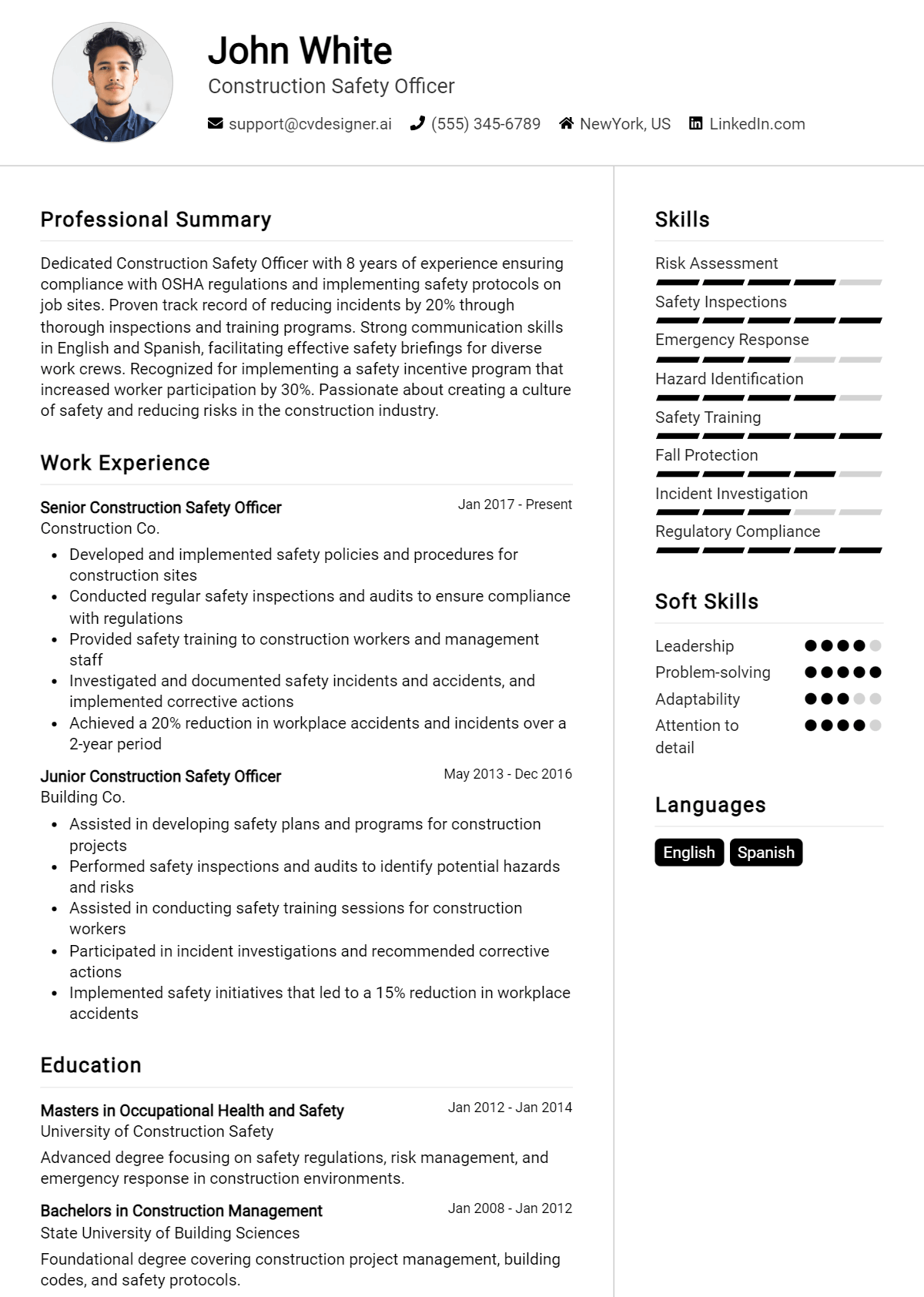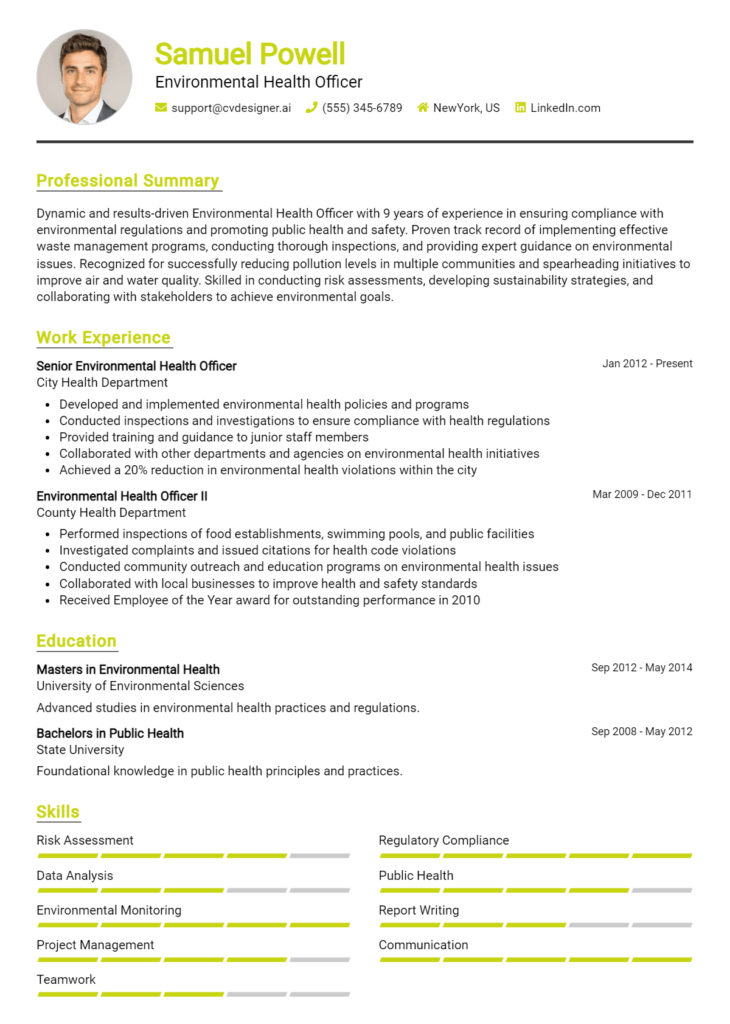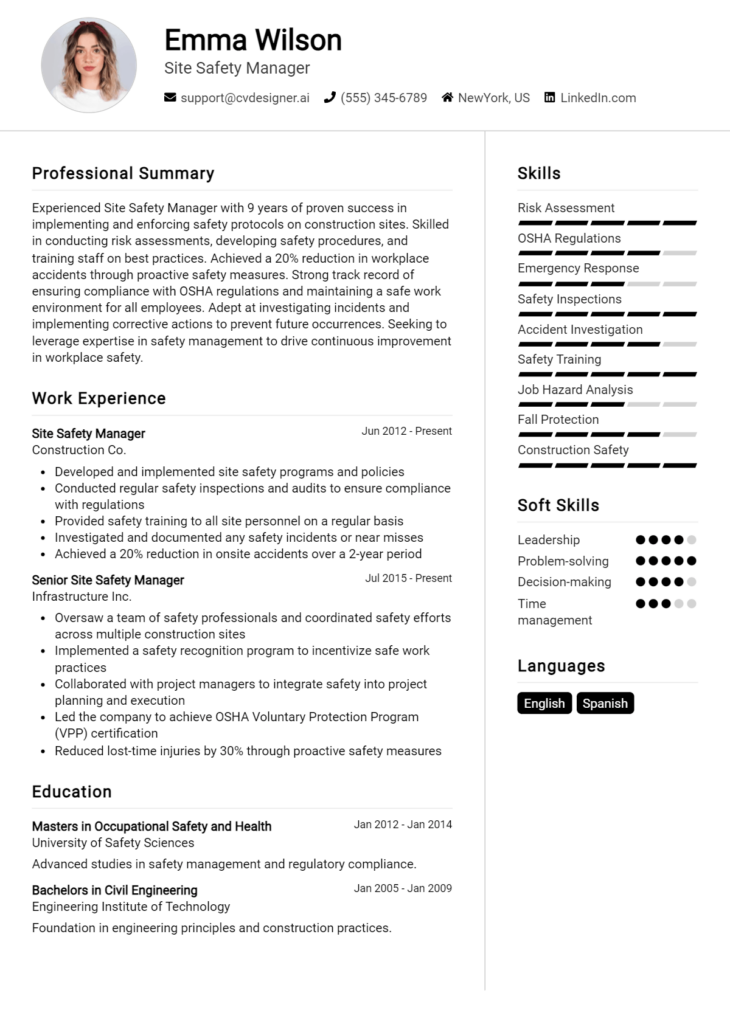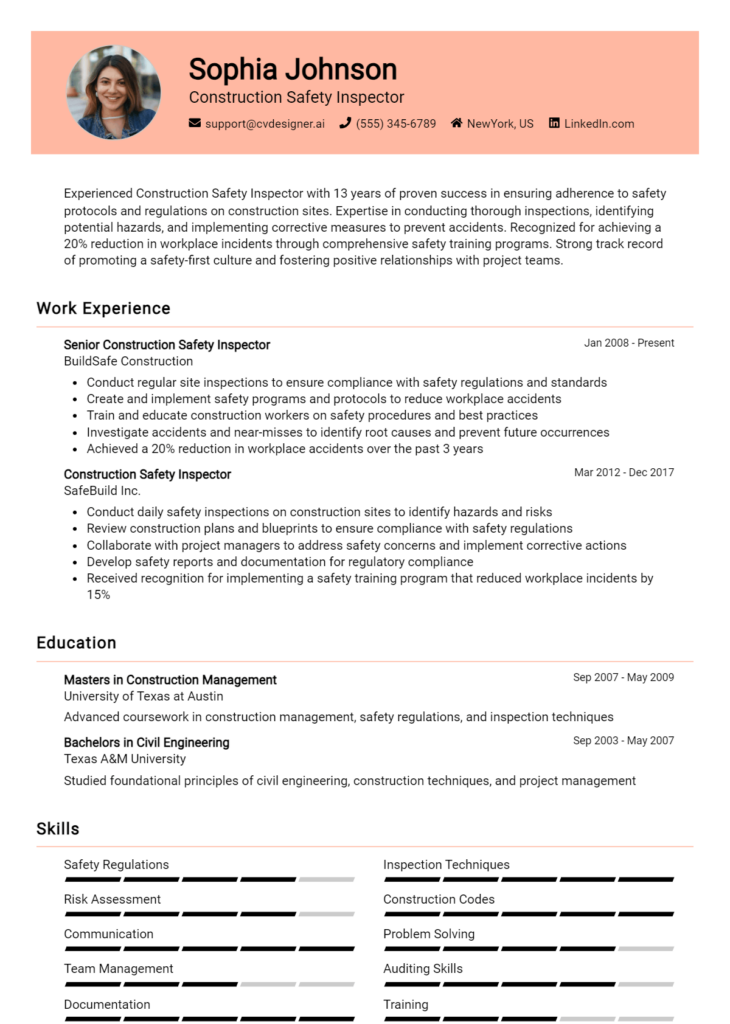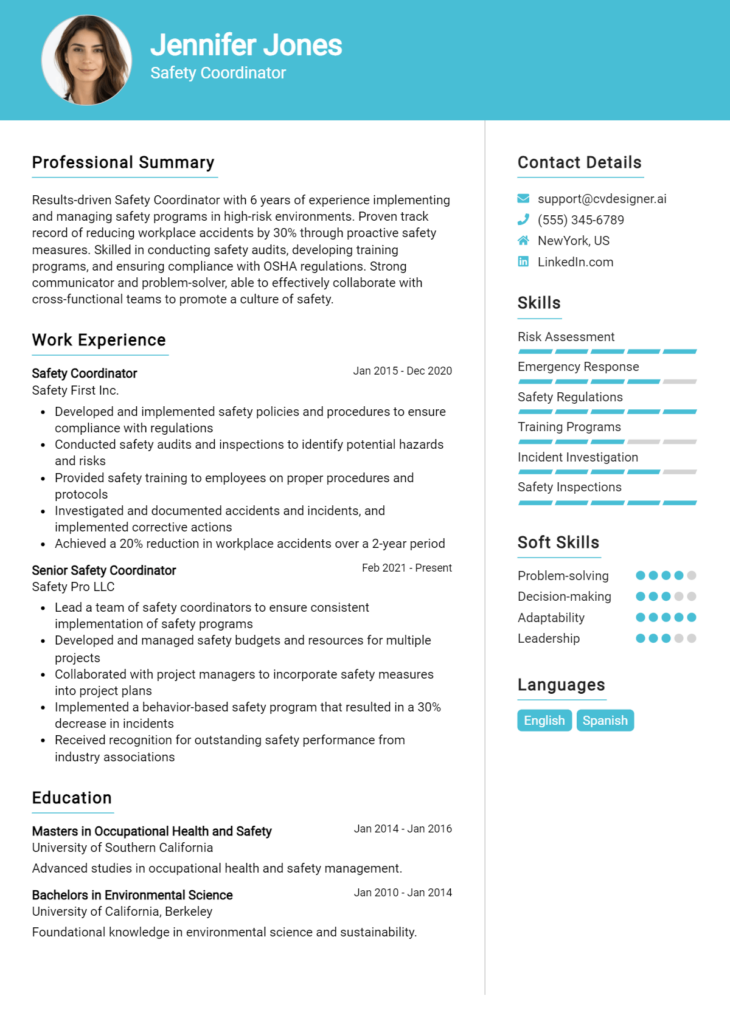Construction Safety Officer Core Responsibilities
A Construction Safety Officer plays a crucial role in ensuring workplace safety by bridging different departments such as operations, human resources, and compliance. Key responsibilities include conducting safety audits, developing safety protocols, and providing training to staff. Essential skills encompass technical knowledge of safety regulations, operational oversight, and strong problem-solving abilities. These competencies not only enhance workplace safety but also align with organizational goals. A well-structured resume can effectively highlight these qualifications, showcasing the candidate's commitment to safety and efficiency.
Common Responsibilities Listed on Construction Safety Officer Resume
- Conduct regular safety inspections and audits on-site.
- Develop and implement safety training programs for employees.
- Ensure compliance with local, state, and federal safety regulations.
- Investigate incidents and accidents to identify root causes.
- Prepare and maintain safety documentation and reports.
- Monitor the use of personal protective equipment (PPE).
- Collaborate with management to develop safety policies.
- Facilitate safety meetings and workshops.
- Conduct risk assessments and recommend corrective actions.
- Provide guidance on emergency response procedures.
- Stay updated on industry trends and regulatory changes.
- Promote a culture of safety throughout the organization.
High-Level Resume Tips for Construction Safety Officer Professionals
In the competitive field of construction safety, a well-crafted resume is not just a formality; it is a vital tool that sets the tone for your first impression with potential employers. As a Construction Safety Officer, your resume needs to effectively showcase your expertise, skills, and achievements in ensuring safety on construction sites. It serves as a reflection of your professional journey and capabilities, making it essential to highlight relevant experiences that align with the job requirements. This guide will provide practical and actionable resume tips tailored specifically for Construction Safety Officer professionals, empowering you to create a standout resume that captures the attention of hiring managers.
Top Resume Tips for Construction Safety Officer Professionals
- Tailor your resume to align with the specific job description, incorporating relevant keywords and phrases.
- Highlight relevant certifications, such as OSHA training or First Aid/CPR, to demonstrate your qualifications.
- Showcase your experience with safety audits, inspections, and incident investigations to illustrate your hands-on expertise.
- Quantify your achievements by using metrics, such as the percentage of incidents reduced or the number of safety trainings conducted.
- Include a strong summary statement that encapsulates your professional background and safety philosophy.
- Emphasize your knowledge of industry regulations and standards to showcase your commitment to compliance.
- List technical skills relevant to construction safety, such as risk assessment tools or safety management software.
- Incorporate soft skills such as communication, leadership, and problem-solving that are crucial in safety management roles.
- Use clear and concise language, and maintain a professional format that enhances readability.
- Consider including a section for professional development, indicating ongoing education or training in safety practices.
Implementing these tips can significantly enhance your chances of landing a job in the Construction Safety Officer field. A resume that effectively showcases your qualifications, experiences, and commitment to safety will resonate with employers, positioning you as a strong candidate ready to contribute to a culture of safety on construction sites.
Why Resume Headlines & Titles are Important for Construction Safety Officer
In the competitive field of construction safety, a well-crafted resume headline or title is crucial for a Construction Safety Officer. This concise phrase serves as the first impression for hiring managers, immediately grabbing their attention and summarizing the candidate's key qualifications in a single impactful statement. A strong headline should encapsulate relevant skills, experience, and accomplishments, making it easier for employers to quickly assess a candidate's fit for the role. By being concise and directly related to the job being applied for, a compelling headline can set a candidate apart from the competition and pave the way for further consideration.
Best Practices for Crafting Resume Headlines for Construction Safety Officer
- Keep it concise: Aim for a headline that is brief yet informative, ideally no more than 10 words.
- Be role-specific: Tailor the headline to reflect the specific job title you are applying for.
- Highlight key strengths: Include your most relevant skills or certifications that align with the job description.
- Use action-oriented language: Start with strong action verbs that convey your proactive approach to safety.
- Incorporate industry keywords: Use terms that are relevant to the construction safety field, enhancing visibility and relevance.
- Avoid jargon: Ensure the headline is easily understood by anyone in the hiring role, not just industry insiders.
- Showcase accomplishments: If applicable, mention notable achievements or contributions to safety improvements.
- Review and revise: Always edit your headline for clarity and impact before submitting your resume.
Example Resume Headlines for Construction Safety Officer
Strong Resume Headlines
Certified Construction Safety Officer with 10+ Years of Experience in Risk Management
Dedicated Safety Professional Specializing in OSHA Compliance and Training
Proven Track Record in Reducing Workplace Accidents by 30%
Experienced Safety Coordinator Committed to Enhancing Site Safety Culture
Weak Resume Headlines
Safety Officer
Looking for a Job in Construction
Experienced Professional
The strong headlines are effective because they provide specific information about the candidate's qualifications and achievements, making it clear why they would be a valuable addition to the team. They incorporate relevant keywords and highlight significant experience, which resonates with hiring managers looking for qualified applicants. In contrast, the weak headlines fail to impress due to their vagueness and lack of detail, leaving hiring managers without a clear understanding of the candidate's strengths or suitability for the role. This can lead to missed opportunities, as generic titles do not differentiate candidates in a crowded applicant pool.
Writing an Exceptional Construction Safety Officer Resume Summary
A well-crafted resume summary is crucial for a Construction Safety Officer as it serves as the first impression for hiring managers. This brief yet powerful overview highlights the candidate's key skills, relevant experience, and notable accomplishments, instantly capturing attention and setting the tone for the rest of the resume. A strong summary should be concise, impactful, and tailored specifically to the job being applied for, ensuring that it resonates with the employer's needs and expectations.
Best Practices for Writing a Construction Safety Officer Resume Summary
- Quantify Achievements: Use numbers and metrics to showcase your impact, such as reducing incidents or improving safety compliance rates.
- Focus on Relevant Skills: Highlight skills that are crucial for the role, such as risk assessment, safety training, and regulatory knowledge.
- Tailor the Summary: Customize the summary for each job application by incorporating keywords and phrases from the job description.
- Be Concise: Aim for 3-5 sentences that effectively communicate your strengths without unnecessary details.
- Showcase Certifications: Include any relevant certifications, such as OSHA or NEBOSH, to demonstrate your qualifications.
- Highlight Leadership Experience: Mention any supervisory roles or experiences in leading safety initiatives that illustrate your ability to manage teams.
- Use Action-Oriented Language: Start with strong action verbs to create an engaging and dynamic narrative.
- Reflect Professionalism: Maintain a formal tone that reflects your expertise and commitment to safety in the construction industry.
Example Construction Safety Officer Resume Summaries
Strong Resume Summaries
Detail-oriented Construction Safety Officer with over 8 years of experience in implementing safety protocols, resulting in a 30% reduction in workplace incidents. Certified in OSHA standards, I have successfully led safety training programs for over 200 employees, enhancing compliance and awareness across multiple projects.
Dedicated Safety Officer with a proven track record of improving safety metrics by 25% over five years. Skilled in conducting risk assessments and developing emergency response plans, I have effectively managed safety operations on large-scale construction sites, ensuring compliance with all local regulations.
Results-driven Construction Safety Officer with a strong background in site inspections and accident investigation. Increased safety compliance rates by over 40% through targeted training initiatives and safety audits, fostering a culture of safety among all team members.
Weak Resume Summaries
Construction Safety Officer with experience in the field. I am dedicated to ensuring safety on construction sites.
Safety Officer looking for a new opportunity to utilize my skills in a construction environment. I believe safety is important.
The examples above illustrate the difference between strong and weak resume summaries. Strong summaries effectively quantify results, highlight specific skills, and directly relate to the job role, demonstrating the candidate's qualifications and achievements. In contrast, weak summaries are vague, lack measurable outcomes, and fail to convey the candidate's unique strengths, making them less compelling to hiring managers.
Work Experience Section for Construction Safety Officer Resume
The work experience section of a Construction Safety Officer resume is essential as it serves as a key indicator of the candidate's technical skills, leadership capabilities, and ability to deliver high-quality results. This section allows potential employers to assess the candidate’s practical knowledge in managing safety protocols, ensuring compliance with regulations, and fostering a culture of safety within construction teams. By quantifying achievements and aligning experiences with industry standards, candidates can effectively demonstrate their impact and readiness for the role, making this section a critical component of a compelling resume.
Best Practices for Construction Safety Officer Work Experience
- Use specific examples to illustrate technical expertise in safety protocols and regulations.
- Quantify results by including metrics, such as reduced incident rates or cost savings from safety initiatives.
- Highlight collaboration with diverse teams, showcasing effective communication and teamwork skills.
- Detail the implementation of safety training programs and their outcomes.
- Align experiences with industry standards and best practices to demonstrate knowledge of current regulations.
- Showcase problem-solving skills by describing challenges faced and solutions implemented.
- Include relevant certifications and how they were applied in previous roles.
- Emphasize leadership roles taken in promoting a safety culture on-site.
Example Work Experiences for Construction Safety Officer
Strong Experiences
- Successfully reduced workplace incidents by 30% over two years by implementing a comprehensive safety training program for over 150 employees.
- Led a cross-functional team to develop a new safety compliance checklist, resulting in a 20% increase in compliance scores during inspections.
- Managed a project that achieved zero safety violations over a 12-month period, earning recognition from local safety authorities.
- Collaborated with contractors to design and execute a safety audit process, which identified and mitigated risks, reducing near-miss incidents by 40%.
Weak Experiences
- Assisted with safety meetings and training sessions.
- Helped to maintain safety equipment and supplies.
- Participated in safety audits and inspections.
- Worked on various construction sites ensuring compliance.
The examples considered strong demonstrate specific achievements and quantifiable results that reflect the candidate's impact on safety performance and their leadership abilities. In contrast, the weak experiences lack detail and fail to convey significant contributions or outcomes, making them less compelling to potential employers. Strong experiences highlight initiative, measurable success, and direct involvement in safety management, whereas weak experiences are vague and do not provide a clear picture of the candidate's capabilities.
Education and Certifications Section for Construction Safety Officer Resume
The education and certifications section of a Construction Safety Officer resume is critical in establishing the candidate's qualifications and commitment to safety in the construction industry. This section serves as a showcase of the candidate's academic background, relevant industry certifications, and dedication to continuous learning. Including pertinent coursework, specialized training, and recognized credentials not only enhances the candidate's credibility but also demonstrates their alignment with the specific requirements of the role. Employers often prioritize candidates who show a proactive approach to their education and qualifications, as it reflects their capability to uphold safety standards and regulations on construction sites.
Best Practices for Construction Safety Officer Education and Certifications
- Focus on relevant degrees, such as Occupational Safety and Health, Environmental Science, or Construction Management.
- List industry-recognized certifications, such as OSHA 30-Hour Safety Training or Certified Safety Professional (CSP).
- Include specialized training courses that pertain to construction safety, such as fall protection or hazard communication.
- Provide details on any continuing education programs that demonstrate your commitment to staying updated with industry standards.
- Highlight any leadership or management training that showcases your ability to oversee safety operations.
- Use clear formatting and bullet points to enhance readability and make key information stand out.
- Be specific about dates and institutions to lend credibility to your qualifications.
- Tailor the content to match the requirements of the job description, emphasizing the most relevant qualifications first.
Example Education and Certifications for Construction Safety Officer
Strong Examples
- Bachelor of Science in Occupational Safety and Health, University of XYZ, 2020
- Certified Safety Professional (CSP), Board of Certified Safety Professionals, 2021
- OSHA 30-Hour Construction Safety Training, Completed 2022
- Hazardous Materials Management Certification, National Institute of Safety, 2023
Weak Examples
- Associate Degree in General Studies, Community College, 2015
- CPR Certification, Expired 2020
- Basic First Aid Course, Completed in 2018 (not construction-specific)
- High School Diploma, 2000 (without additional relevant training)
The strong examples listed above highlight relevant degrees and certifications that directly support the responsibilities of a Construction Safety Officer, demonstrating both specialized knowledge and current industry standards. In contrast, the weak examples lack relevance and do not showcase a commitment to safety in the construction environment. They either include outdated certifications or qualifications that do not align with the specific needs of the role, which would not effectively bolster a candidate's profile in the eyes of employers.
Top Skills & Keywords for Construction Safety Officer Resume
As a Construction Safety Officer, possessing the right skills is crucial for ensuring a safe working environment on construction sites. A well-crafted resume that highlights both hard and soft skills can significantly enhance your prospects in this competitive field. Employers look for candidates who not only have the technical knowledge required to enforce safety regulations but also the interpersonal skills needed to communicate effectively with workers and management alike. Showcasing these skills in your resume can demonstrate your capability to uphold safety standards and foster a culture of safety within the organization.
Top Hard & Soft Skills for Construction Safety Officer
Soft Skills
- Strong communication skills
- Leadership abilities
- Problem-solving aptitude
- Attention to detail
- Team collaboration
- Conflict resolution
- Adaptability
- Time management
- Critical thinking
- Empathy and emotional intelligence
Hard Skills
- Knowledge of OSHA regulations
- Risk assessment and management
- Safety training and education
- Incident investigation techniques
- Proficiency in safety software and tools
- Emergency response planning
- Safety auditing and inspections
- First aid and CPR certification
- Environmental health and safety (EHS) standards
- Construction site safety protocols
By incorporating these essential skills into your resume, you can effectively illustrate your qualifications for the role of Construction Safety Officer. Additionally, emphasizing your work experience related to safety management can further strengthen your application.
Stand Out with a Winning Construction Safety Officer Cover Letter
Dear [Hiring Manager's Name],
I am writing to express my interest in the Construction Safety Officer position at [Company Name], as advertised on [Where You Found the Job Posting]. With over [X years] of experience in the construction industry and a proven track record of implementing effective safety protocols, I am confident in my ability to contribute to your team and ensure a safe working environment for all employees. My certifications in OSHA regulations and First Aid/CPR complement my hands-on experience in site inspections, risk assessment, and safety training.
Throughout my career, I have successfully developed and enforced safety policies that have led to a significant reduction in workplace incidents. At [Previous Company Name], I conducted comprehensive audits and provided training sessions that increased employee awareness of safety practices. By fostering a culture of safety, I was able to reduce injury rates by [X%] within my first year. I am adept at identifying potential hazards and implementing corrective actions, ensuring compliance with both federal regulations and company standards.
I am particularly drawn to the opportunity at [Company Name] because of your commitment to safety and innovation within the construction field. I am eager to bring my expertise in safety management and my proactive approach to problem-solving to your team. I am excited to collaborate with project managers and construction crews to ensure that safety remains a top priority on every project.
Thank you for considering my application. I look forward to the opportunity to discuss how my skills and experience align with the goals of [Company Name]. I am enthusiastic about the prospect of contributing to your team and helping to create a safe and productive work environment.
Sincerely,
[Your Name]
[Your Contact Information]
[LinkedIn Profile or Professional Website, if applicable]
Common Mistakes to Avoid in a Construction Safety Officer Resume
When crafting a resume for a Construction Safety Officer position, it's crucial to present your qualifications and experience effectively. However, many candidates make common mistakes that can undermine their chances of landing an interview. Avoiding these pitfalls can help you create a compelling resume that highlights your expertise in ensuring workplace safety. Here are some frequent missteps to steer clear of:
Neglecting Relevant Certifications: Failing to prominently display certifications such as OSHA or NEBOSH can make your resume less appealing to employers looking for qualified candidates.
Using Vague Language: Describing your responsibilities in general terms rather than providing specific examples can make your accomplishments seem less impressive. Use concrete metrics or achievements to demonstrate your impact on safety protocols.
Overloading with Irrelevant Experience: Including unrelated job experiences can dilute the focus of your resume. Stick to positions that showcase your safety expertise and relevant skills in the construction industry.
Ignoring Keywords from Job Descriptions: Many companies use applicant tracking systems (ATS) to filter resumes. Not incorporating keywords from the job listing can result in your resume being overlooked.
Inconsistent Formatting: A cluttered or inconsistent layout can distract from the content of your resume. Use a clean, professional format with uniform fonts and bullet points for clarity.
Failing to Tailor the Resume: Sending a generic resume for multiple job applications can be detrimental. Customize your resume for each position to reflect the specific requirements and desired qualifications.
Omitting Soft Skills: While technical skills are essential, soft skills like communication and teamwork are equally important. Be sure to highlight your ability to work collaboratively and effectively with diverse teams.
Not Including Continued Education: The field of safety regulation is always evolving. Failing to mention ongoing education, workshops, or training can signal a lack of commitment to professional growth in safety practices.
Conclusion
As a Construction Safety Officer, your primary responsibility is to ensure a safe working environment on construction sites. This role involves conducting regular safety inspections, implementing safety protocols, providing training to workers, and ensuring compliance with safety regulations. It's essential to stay updated on the latest safety standards and practices to minimize risks and prevent accidents.
In this article, we discussed the skills and qualifications necessary for a successful Construction Safety Officer, including strong communication abilities, attention to detail, knowledge of safety regulations, and the ability to lead safety training sessions. We also highlighted the importance of certifications such as OSHA and First Aid/CPR, which enhance your credibility and effectiveness in the role.
In conclusion, if you aim to stand out in your career as a Construction Safety Officer, it’s crucial to have a polished resume that accurately reflects your skills and experience. Take the time to review your resume and ensure it aligns with industry standards. To assist you in this process, consider utilizing helpful tools like resume templates, a resume builder, resume examples, and cover letter templates. Elevate your application and make your next career move a successful one!

